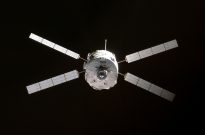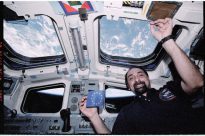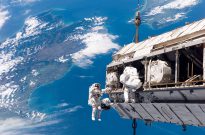International Space Station (ISS)
The International Space Station (ISS) is a research facility currently being assembled in Low Earth Orbit. On-orbit construction of the station began in 1998, and is scheduled to be complete by 2011, with operations continuing until around 2015. As of 2009, the ISS is the largest artificial satellite in Earth orbit, larger than any previous space station.

In partnership with the United States, Russia, Japan and Canada, Europe is sharing in the greatest international project of all time – the International Space Station (ISS). Once completed, the 450-tonne International Space Station will have more than 1200 cubic metres of pressurized space – enough room for seven crew and a vast array of scientific experiments. Europe, working through ESA, is exclusively responsible for two key station elements: the Columbus Orbital Facility and the Automated Transfer Vehicle (ATV).
The Colombus Orbital Facility represents a substantial part of the station’s research capability. Fitted with 10 interchangeable payload racks, Columbus is a multifunction laboratory that will specialise in research into fluid physics, materials science and life sciences. Europe’s second biggest contribution is the Automated Transfer Vehicle (ATV), a supply ship lifted into orbit by the Ariane-5 launcher. The ATV will carry up to nine tonnes of cargo including provisions, scientific payloads and rocket propellant. Once docked, the craft can use its motor to boost the station higher in its orbit, thus counteracting the faint drag from the Earth’s atmosphere.
Apart from Columbus and the ATV, Europe’s scientists and engineers are also contributing other elements, equipment and design skills across much of the ISS. The DSM-R data management system, for example, has been a key part of the station’s ‘brain’ since its July 2000 launch aboard the Russian Zvezda Service Module. Europe will build two of the three nodes that link station components, as well as the Cupola – a dome-like structure that will be the crew’s panoramic window on space and a control room for astronauts operating station equipment. The European Robotic Arm will service payloads on a later Russian external platform and the Italian pressurised transfer modules – Leonardo, Raffaello and Donatello – will carry pressurized cargo to and from the station.
In fact, European technology will play a part in most station sections. Inside the United States Destiny research module, for instance, Europe will mount, among other equipment, a specialized material science rack and freezer units. The Japanese Experiment Module will also use a European freezer. Europe will also be providing people. European astronauts have flown in space since 1983 and since 1998 the European Astronaut Centre in Cologne has concentrated on training men and women for future ISS missions. The first European to serve a tour of duty on the ISS, Umberto Guidoni, went on mission to the ISS in April 2001.
Only a tiny fraction of the Europeans working on the ISS will ever visit space of course. Just because the ISS is nowadays the brightest object in the night sky – after the moon – it is easy to forget that much of the project’s people and hardware are based not out in space but firmly on the ground. European mission control centres will share station command with Russia and the United States and direct on-board experiments. The astronaut/researchers on the ISS will always be part of a much larger scientific team on Earth.
Right now, Europe’s participation in the ISS means that throughout ESA’s Member States, thousands of Europe’s brightest people at hundreds of universities and high-technology companies are working on the leading edge of 21st-century science and engineering. Once the station is up and running, these people will be among the first to benefit from the space research facilities they have helped to build.




